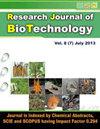2、4 和 2、6-二叔丁基苯酚与 NAGK 和 SPP1 蛋白的分子对接研究,以治疗类风湿性关节炎
IF 0.2
Q4 BIOTECHNOLOGY & APPLIED MICROBIOLOGY
引用次数: 0
摘要
类风湿性关节炎(RA)是一种主要影响滑膜关节的慢性自身免疫性疾病。它与渐进性残疾、早死和社会经济负担有关。因此,迫切需要开发新型药物,在疾病进展的各个阶段对患者进行有效治疗。N-乙酰葡糖胺激酶(NAGK)和分泌型磷蛋白1(SPP1)是治疗RA的两个具有吸引力的药物靶点。NAGK 蛋白可将内源性 N-乙酰-D-葡糖胺(GlcNAc)转化为 GlcNAc 6-磷酸。GlcNAc 对小鼠模型中的实验性 RA 有抑制作用。SPP1 可刺激一种关键的促炎细胞因子的合成,这种细胞因子与 RA 的发病机制有关。为了设计新的候选药物,我们从蛋白质数据库中检索到了人类 NAGK(PDB Id:2CH5)的晶体结构。从uniprot数据库中检索了SPP1(Uniprot Id:P10451)的氨基酸序列,并通过Phyre2服务器建立了模型。利用 YASARA 能量最小化服务器将计算出的 SPP1 模型能量最小化,并通过拉马钱德兰图和 ProSA-web 错误检测工具进行验证。2,4-二叔丁基苯酚和2,6-二叔丁基苯酚是从Schleichera oleosa树皮提取物中分离出来的已知化合物,具有抗关节炎和消炎活性。这些化合物通过 MTiAutoDock 服务器与 NAGK 和 SPP1 蛋白的活性位点对接。这些化合物与 NAGK 和 SPP1 蛋白的结合亲和力为 -6.12 至 -7.17 kcal/mol。这项研究的发现将为开发基于油茶属植物的类风湿关节炎草药疗法开辟道路,并有可能开发出新型药物。本文章由计算机程序翻译,如有差异,请以英文原文为准。
In silico molecular docking studies of 2, 4 and 2, 6-di-tert-butylphenol against NAGK and SPP1 proteins to recuperate rheumatoid arthritis
Rheumatoid arthritis (RA) is a chronic autoimmune disorder that primarily affects the synovial joints. It is connected to progressive disability, early death and socioeconomic burdens. So, there is an urgent need to develop novel drugs that effectively treat patients at each stage of disease progression. N-acetylglucosamine kinase (NAGK) and secreted phosphoprotein 1(SPP1) are two attractive drug targets for RA. NAGK protein converts endogenous N-acetyl-D-glucosamine (GlcNAc) into GlcNAc 6-phosphate. GlcNAc has suppressive effects on experimental RA in mouse models. SPP1 stimulates the synthesis of a key proinflammatory cytokine implicated in the pathogenesis of RA. In order to design new drug candidates, crystal structure of human NAGK (PDB Id: 2CH5) was retrieved from the protein data bank. Amino acid sequence of SPP1 (Uniprot Id: P10451) was retrieved from uniprot database and modeled by the Phyre2 server. Computed SPP1 model energy was minimized using the YASARA energy minimization server and validated by the Ramachandran plot and the ProSA-web error-detection tool. 2, 4-Di-tert-butylphenol and 2, 6-Di-Tert-butylphenol are known compound isolates from bark extract of Schleichera oleosa having anti-arthritic and anti-inflammatory activities as accessed by PASS online server. These compounds were docked against active site of NAGK and SPP1 proteins using MTiAutoDock server. The binding affinity of these compounds against NAGK and SPP1 proteins ranges from -6.12 to -7.17 kcal/mol. The findings of this study will open the way for the development of herbal remedies for rheumatoid arthritis based on the Schleichera oleosa plant, potentially leading to the development of novel drugs.
求助全文
通过发布文献求助,成功后即可免费获取论文全文。
去求助
来源期刊

Research Journal of Biotechnology
BIOTECHNOLOGY & APPLIED MICROBIOLOGY-
CiteScore
0.60
自引率
0.00%
发文量
192
期刊介绍:
We invite you to contribute Research Papers / Short Communications / Review Papers:
-In any field of Biotechnology, Biochemistry, Microbiology and Industrial Microbiology, Soil Technology, Agriculture Biotechnology.
-in any field related to Food Biotechnology, Nutrition Biotechnology, Genetic Engineering and Commercial Biotechnology.
-in any field of Biotechnology related to Drugs and Pharmaceutical products for human beings, animals and plants.
-in any field related to Environmental Biotechnolgy, Waste Treatment of Liquids, Soilds and Gases; Sustainability.
-in inter-realted field of Chemical Sciences, Biological Sciences, Environmental Sciences and Life Sciences.
-in any field related to Biotechnological Engineering, Industrial Biotechnology and Instrumentation.
-in any field related to Nano-technology.
-in any field related to Plant Biotechnology.
 求助内容:
求助内容: 应助结果提醒方式:
应助结果提醒方式:


